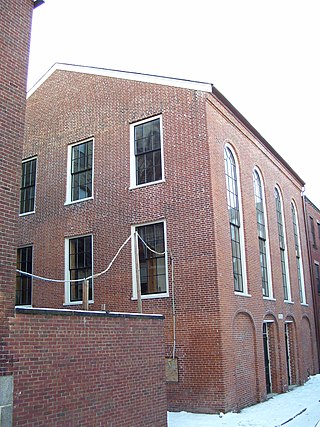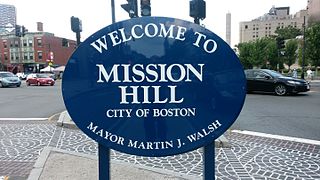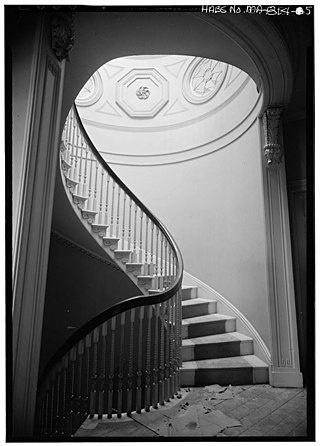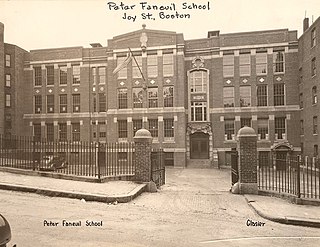
Brookline is a town in Norfolk County, Massachusetts, United States, and part of the Boston metropolitan area. An exclave of Norfolk County, Brookline borders six of Boston's neighborhoods: Brighton, Allston, Fenway–Kenmore, Mission Hill, Jamaica Plain, and West Roxbury. The city of Newton borders Brookline to the west. It is known as the birthplace of John F. Kennedy.

Emerson College is a private college with its main campus in Boston, Massachusetts. It also maintains campuses in Hollywood, Los Angeles, California and Well, Limburg, Netherlands. Founded in 1880 by Charles Wesley Emerson as a "school of oratory," the college offers more than three dozen degree and professional training programs specializing in the fields of arts and communication with a foundation in liberal arts studies. The college is one of the founding members of the ProArts Consortium, an association of six neighboring institutions in Boston dedicated to arts education at the collegiate level. Emerson is also notable for the college's namesake public opinion poll, Emerson College Polling.

Charles Bulfinch was an early American architect, and has been regarded by many as the first American-born professional architect to practice.

Faneuil Hall is a marketplace and meeting hall located near the waterfront and today's Government Center, in Boston, Massachusetts. Opened in 1742, it was the site of several speeches by Samuel Adams, James Otis, and others encouraging independence from Great Britain. It is now part of Boston National Historical Park and a well-known stop on the Freedom Trail. It is sometimes referred to as "the Cradle of Liberty," though the building and location have ties to slavery.

Beacon Hill is a historic neighborhood in Boston, Massachusetts, United States, and the hill upon which the Massachusetts State House resides. The term "Beacon Hill" is used locally as a metonym to refer to the state government or the legislature itself, much like Washington, D.C.'s Capitol Hill does at the federal level.

The African Meeting House, also known variously as First African Baptist Church, First Independent Baptist Church and the Belknap Street Church, was built in 1806 and is now the oldest black church edifice still standing in the United States. The church also established a school, at first holding classes in its basement. After serving most of the nineteenth century as a church, it then served as a synagogue until 1972 when it was purchased for the Museum of African American History. It is located in the Beacon Hill neighborhood of Boston, Massachusetts, adjacent to the historically Black American Abiel Smith School, now also part of the museum. It is a National Historic Landmark.

The Boston National Historical Park is an association of sites that showcase Boston's role in the American Revolution and other parts of history. It was designated a national park on October 1, 1974. Seven of the eight sites are connected by the Freedom Trail, a walking tour of downtown Boston. All eight properties are National Historic Landmarks.

The Boston African American National Historic Site, in the heart of Boston, Massachusetts's Beacon Hill neighborhood, interprets 15 pre-Civil War structures relating to the history of Boston's 19th-century African-American community, connected by the Black Heritage Trail. These include the 1806 African Meeting House, the oldest standing black church in the United States.

Abiel Smith School, founded in 1835, is a school located at 46 Joy Street in Boston, Massachusetts, United States, adjacent to the African Meeting House. It is named for Abiel Smith, a white philanthropist who left money in his will to the city of Boston for the education of black children.

Mission Hill is a 3⁄4 square mile, primarily residential neighborhood of Boston, bordered by Roxbury, Jamaica Plain and Fenway-Kenmore and the town of Brookline. The neighborhood has two main streets, namely Tremont Street and Huntington Avenue. It is served by several stations on the MBTA's Green Line E branch, as well as Roxbury Crossing station on the Orange Line.

Cheers Beacon Hill is a bar/restaurant located on Beacon Street in the Beacon Hill neighborhood of Boston, Massachusetts, across from the Boston Public Garden. Founded in 1969 as the Bull & Finch Pub, the bar is best remembered internationally as the exterior of the bar seen in the NBC sitcom Cheers, which ran between 1982 and 1993. The Bull & Finch changed its name to Cheers in 2002 after closing a deal with NBC.

Tremont Street is a major thoroughfare in Boston, Massachusetts.

The Nathan Appleton Residence, also known as the Appleton-Parker House, is a historic house located at 39–40 Beacon Street in the Beacon Hill neighborhood of Boston, Massachusetts. It was designated a National Historic Landmark for its association with revolutionary textile manufacturer Nathan Appleton (1779–1861), and as the site in 1843 of the wedding of his daughter Frances and poet Henry Wadsworth Longfellow. The house is an excellent early 19th century design of Alexander Parris.

Downtown Boston is the central business district of Boston, Massachusetts, United States. Boston was founded in 1630. The largest of the city's commercial districts, Downtown is the location of many corporate or regional headquarters; city, county, state and federal government facilities; and many of Boston's tourist attractions. Similar to other central business districts in the U.S., Downtown has recently undergone a transformation that included the construction of new condos and lofts, renovation of historic buildings, and arrival of new residents and businesses. It is represented in the Boston City Council by District 2's Bill Linehan.

William Cooper Nell was an American abolitionist, journalist, publisher, author, and civil servant of Boston, Massachusetts, who worked for the integration of schools and public facilities in the state. Writing for abolitionist newspapers The Liberator and The North Star, he helped publicize the anti-slavery cause. He published the North Star from 1847 to 1851, moving temporarily to Rochester, New York.

The Francis Parkman House is a National Historic Landmark at 50 Chestnut Street, on Beacon Hill in Boston, Massachusetts. Speculated to be designed by Cornelius Coolidge and built in 1824, it is one of a series of fine brick townhouses on Beacon Hill. Its significance lies in its ownership and occupancy by noted historian and horticulturalist Francis Parkman (1823–1893) from 1865 until his death. While living here, Parkman produced a significant portion of his landmark work, France and England in North America, a multi-volume epic history recounting the conflict for control of North America in the 17th and 18th centuries.

Charles Street African Methodist Episcopal Church is an historic African Methodist Episcopal Church at 551 Warren Street in Boston, Massachusetts. The current church building was built in 1888 by J. Williams Beal and added to the National Register of Historic Places in 1983.

Another Course to College (ACC) is a Public Pilot School located in Hyde Park, Boston, Massachusetts, United States.

James T. Kelley (1855–1929) was an American architect practicing in Boston, Massachusetts.























